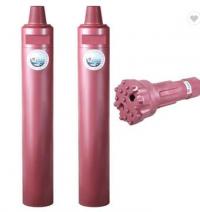Categories
Tags
-
#DTH Hammer
#DTH Bit
#Reaming Bit
#Extension Drilling Tools
#Top Hammer Drilling Tools
#DTH Drill Pipe
#Tapered Bit
#Drill pipe
#China Water Well Drilling Tools
#Drilling Tools Manufacturer
#Water Well Drilling Tools suppliers
#Button Bits suppliers
#Middle Air Pressure DTH Hammers
#Montabert Shank Adapters
Archives
Introduction Of Several Failures Of Reaming Bit
-
Blasting Reaming Bit
Drill pipe fatigue. Fatigue is generally regarded as microcracks, macro cracks and cracks in drill strings and drill pipes. These problems are usually caused by corrosion and cyclic stress.Unscrew. Twisting occurs when the drill string breaks into two sections. This is usually the result of over-tightening or high torque encountered during large displacement or directional drilling.
parting. Excessive tensile stress will lead to demoulding. When over-tension is applied to compensate for adhesion, separation usually occurs.
Burst or fold. When excessive internal or external pressure is applied, the pipeline may burst or collapse.
Unfortunately, although some measures can be taken to manage the pressure on tubular products, including proper handling, storage, and inspection, it may not be possible to completely eliminate drill pipe failures.
Cyclic stress
Cyclic stress often occurs in directional wells because the drill string undergoes both tension and compression. Drill string edgeCyclic stress
Cyclic stress
The curvature of the well, so one side of the rope bears more tension and the other side bears more compression. This process will generate structural stress and will greatly shorten the life expectancy of the drill pipe.To reduce cyclic stress, the operator should minimize the severity of any dog legs to provide a straighter path for the drill string. Trying to control drill string vibration will also help eliminate structural stresses that exacerbate cyclic stress.
corrosion
Corrosion can be caused by a variety of chemicals in the drilling mud that interact with the drill pipe. The most common culprits of corrosion include oxygen,Drill pipe corrosion
Drill pipe corrosion
Carbon dioxide and hydrogen sulfide. The salts and organic acids in the mud can also cause corrosion. Although corrosion cannot always be eliminated due to the nature of the work, changing the chemical composition of the drill pipe can help with the use of corrosive scavengers to help control the pH of the mud, especially when hydrogen sulfide is present.Sticky tube
When the pipe cannot be released and pulled out of the hole without damage, this is called a jam or pipe jam. There are two types of pipe jams: differential pressure and mechanical jams.When part or all of the drill string is embedded in the mud, pressure sticking occurs. This type of adhesion can usually be solved by diluting with nitrogen or gasifying the weight of the mud to reduce the pressure.
When the drill cuttings drilled from the annulus are not completely removed or there is borehole instability, mechanical jamming will occur. To release a mechanically jammed pipe, the cause of the problem must be corrected.
Damaged drill pipe thread
Drill pipe threads can be damaged in many ways, such as adverse drilling conditions, operator error, improper storage or manufacturing errors. Proper maintenance, storage, use and inspection of drill pipes can help owners avoid thread damage. Consistently using high-quality thread protection will also ensure that the threads are in good working condition.Borehole instability
The term borehole instability refers to the inability to maintain its shape, size or structural integrity. The instability of the borehole can be caused by many factors, such as earth movement, water absorption, dispersion, overburden or pore pressure. Wellbore instability can cause many problems, such as the aforementioned stuck pipe, bridging and filling, logging difficulties, and borehole enlargement.In order to reduce the risk of borehole instability, drilling operators are encouraged to use appropriate borehole fluids and hydraulics, determine the appropriate borehole trajectory, select the correct mud weight, and minimize open hole time.
Over torque
Excessive torque is one of the most common causes of thread damage. When the drill pipe receives insufficient force before going down the well, excessive torque will occur. When there is not enough torque into the hole, it will continue to tighten as it descends, causing it to be over tightened. The most effective way to avoid excessive torque is to ensure that all connections are properly tightened in accordance with the specifications before use. This may require more planning, but determining the optimal torque helps to minimize the risk of excessive torque and damage to Extension Drilling Tools threads.Lose the loop
Plugging is a term that describes the uncontrolled flow of drilling mud into the formation. This happens when the pressure on the formation exceeds the total pressure of the formation. This is especially common when the ground is spongy, natural, permeable, natural, or easily broken or depleted. Plugging is problematic because it will lead to increased mud costs and underground blowouts.In most cases, lost circulation can be avoided by maintaining proper acre weight, minimizing annulus fracture loss, using proper formation pressure and fracture gradient, and avoiding annulus space constraints.
